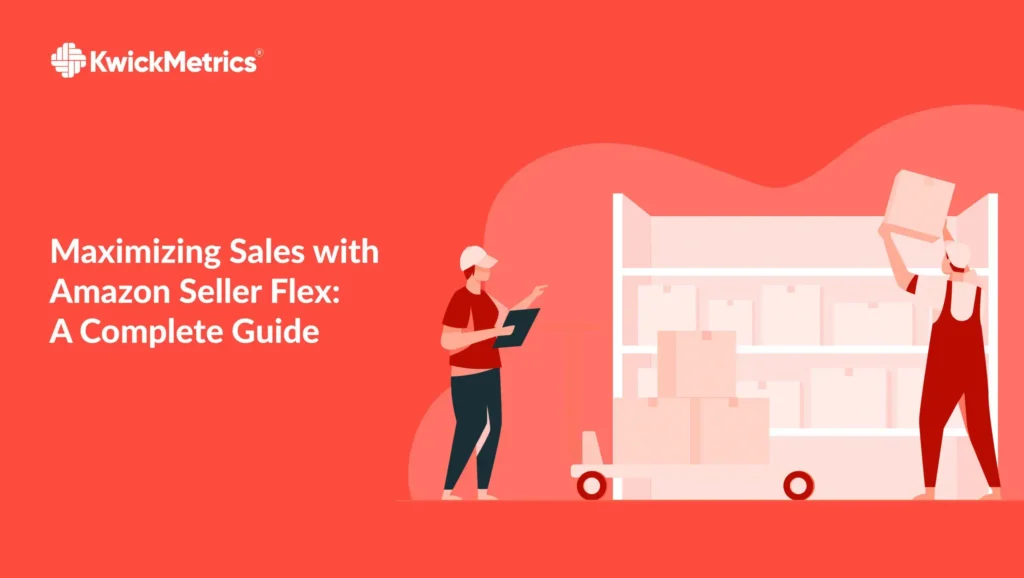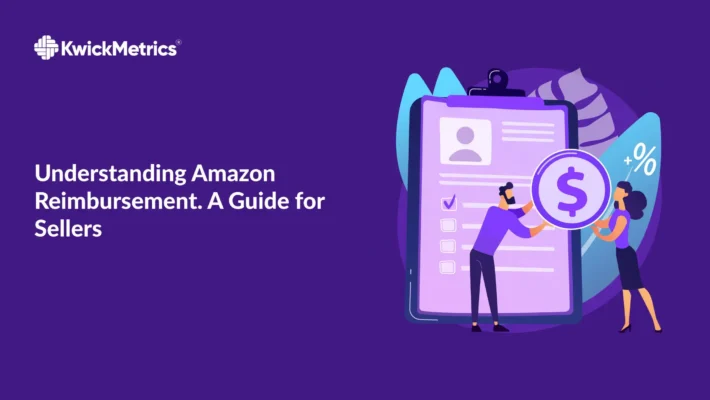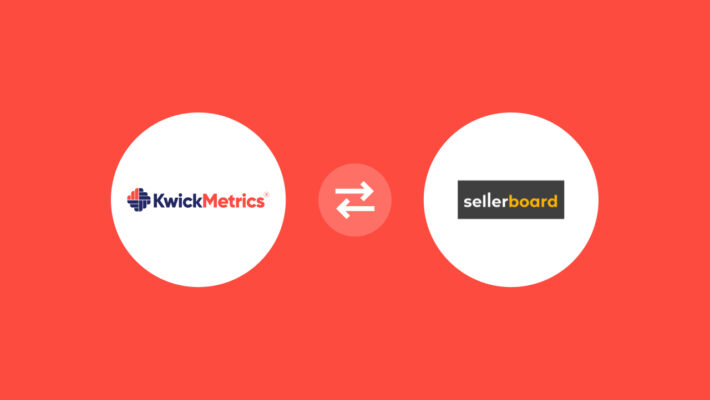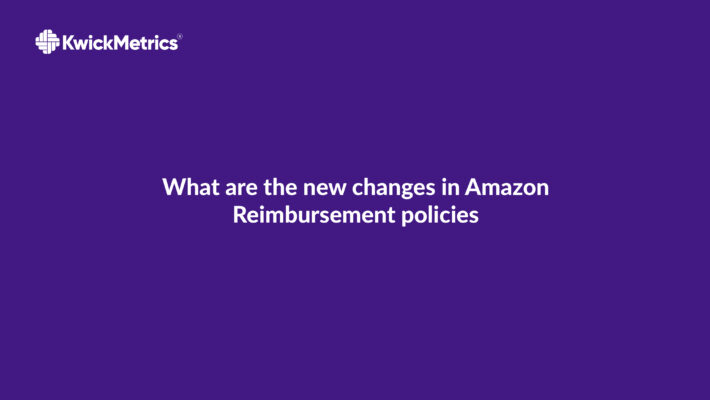Maximizing Sales with Amazon Seller Flex: A Complete Guide

Table of Contents
- What is Amazon Seller Flex
- Boost Your Sales With KwickMetrics
- Eligibility Criteria for Enrolling in Amazon’s Seller Flex Program
- The Inner Workings of The Amazon’s Seller Flex Program
- Amazon’s Seller Flex Vs FBA: A Comprehensive Comparison
- Try Our KwickMetrics - One Tool with Multiple Solutions!
- Product Eligibility For Amazon’s Seller Flex
- The Future Of Amazon’s Seller Flex (2023 And Beyond)
- Pros and Cons of Seller Flex for E-commerce Sellers
- KwickMetrics Amazon Reimbursement Service - Your Key to Maximise Profits!
- Reimbursement Policies For Amazon Seller Flex
- FAQs in Relation to Amazon Seller Flex
- Conclusion
Ever heard of Amazon Seller Flex? Well, it’s more than just a buzzword in the e-commerce universe. Picture this: you’re an Amazon seller and you’ve got total control over your inventory management. You handle packing and shipping from your own warehouse, yet still enjoy all the benefits of FBA – faster delivery times, prime eligibility…you name it.
This isn’t some far-fetched dream but reality with the Amazon Seller Flex program. Have the best of both worlds! But hold on; what makes this so special compared to other programs? What does it require to be a part of this promising opportunity?
We’re going to unpack all the details of this cutting-edge method. We’ll cover its distinct benefits, how you can figure out if you qualify for sign-up, valuable insights on handling inventory effectively under the Seller Flex Program, and even some handy tips when deciding between Seller flex vs FBA.
What is Amazon Seller Flex
The Amazon Seller Flex program, often just referred to as “Seller Flex”, is an invite-only service that gives sellers more control over their inventory management. As part of the program, you can store and pick-pack your goods in your own depository while enjoying benefits like one or two-day delivery.
Breaking Down the Concept of Amazon Seller Flex
This innovative approach offers a new way for businesses to leverage Amazon’s platform. The key idea behind it? Giving power back to sellers. Rather than having products shipped from an FBA warehouse, participants in this program keep items at their location until orders are placed by customers.
You might think of it as a hybrid between traditional FBA and merchant-fulfilled listings: You handle storage but let Amazon take care of shipping and customer support. So if we’re talking about amazon seller flex vs FBA, both have unique advantages depending on your specific business needs.
How does Amazon Seller Flex Work?
Upon receiving an order, the seller assumes the responsibility of meticulously packaging the ordered items, utilizing the packaging materials supplied by Amazon. Following this step, the Amazon Transportation System (ATS) seamlessly takes charge of the subsequent phases, encompassing the intricate processes of shipping and delivering the package to the customer within the pre-defined timeframe. This entails the intricacies of order consolidation, route optimization, last-mile delivery, and all the logistical intricacies that ensure a punctual and efficient delivery experience for the end customer.
Requirements to Start a Seller Flex Site
Before commencing operations as a Flex Site, Amazon has established a set of stringent guidelines that sellers are required to strictly adhere to. Central to these guidelines is the imperative need for efficient packaging processes. To facilitate this, sellers are encouraged to equip themselves with a range of essential machinery and equipment, such as Barcode Scanners, A4 Laser Printers, Shipping Label Printers, Gift Label Printers, UPS Inverters for power backup, Amazon Prime Packing materials, as well as racks and bins. While this list enumerates key elements, it is important to note that it is not exhaustive. To ensure comprehensive compliance, sellers are strongly recommended to consult with their respective Flex Site managers to ascertain the precise requirements tailored to their operational needs.
The Unique Benefits Offered by Seller Flex
But what sets this apart from other programs offered by the e-commerce giant? There are several unique advantages associated with using the seller flex amazon process:
-
- Faster Delivery Times: With closer proximity to products, there’s potential for quicker shipment turnaround times.
- Better Inventory Control: You manage stock levels directly which can lead to fewer out-of-stock instances. And, “Fulfilled By Amazon” label on your products leading to more trust among buyers
- Simplified Fees Structure: Say goodbye to complicated calculations. With clear cut fees based on cubic feet stored monthly rather than per item sold; managing finances becomes easier. Save transportation costs that were incurred in moving goods from your warehouse to Amazon’s warehouse.
In essence, participating in the Seller Flex program is like having your own mini Amazon Fulfillment Center, right in your backyard. But it’s not for everyone: Eligibility for the seller flex program is by invitation only, based on criteria such as monthly sales, seller rating, and units sold.
Amazon operates stores worldwide allowing businesses to grow internationally with programs like this one. So if you’re a motivated amazon business owner looking to expand globally or just want more control over inventory management without additional costs – keep an eye out for that invite.
Boost Your Sales With KwickMetrics
Explore 14-day free trial! No credit card required, cancel at any time.
Key Takeaway:
Amazon's Seller Flex program hands control back to sellers, letting you store and manage inventory at your own location while enjoying the perks of swift delivery times. Think of it as having a mini Amazon fulfillment center right in your backyard. This invite-only service is a game-changer for businesses eyeing global expansion or wanting more grip on their stock without extra costs.
Eligibility Criteria for Enrolling in Amazon’s Seller Flex Program
If you’re an Amazon seller, the opportunity to enroll in the exclusive Seller Flex program might be on your radar. Can you qualify for Amazon’s Seller Flex Program? Let’s unravel this question.
Determining Your Eligibility for the Program
The first thing to note is that eligibility for the Seller Flex program isn’t open to everyone – it operates on an invitation-only basis. This approach allows Amazon to handpick sellers based on a specific set of criteria, ensuring only those who can benefit most from this service are invited.
To get into specifics, Amazon primarily looks at three key factors: monthly sales volume, seller rating and units sold. These parameters allow them assess your ability as a seller and gauge whether you would be a good fit for their program.
-
- Monthly Sales: To meet eligibility requirements, potential candidates need impressive monthly sales figures. This reflects not just high demand but also consistency in performance which is crucial within any business operation.
- Seller Rating: Having a solid reputation as an amazon seller boosts your chances significantly when it comes being considered by Amazon flex managers. A higher rating indicates customer satisfaction with both product quality and delivery standards.
- Units Sold: Lastly, having robust unit sales contributes towards eligibility because this implies strong inventory management capabilities – another important aspect within e-commerce logistics landscape.
These insights can be better analysed with the help of KwickMetrics, a Business Analytics and Reimbursemnet Tool for Amazon Sellers. With these considerations taken into account, successful invitees will then receive instructions via email detailing next steps including where they can find the registration form online.
Remember though – being invited doesn’t guarantee acceptance. Amazon will still need to check the info you supply during registration.
If you’re wondering, “what is seller flex?”, this program gives sellers greater control over their FBA warehouse operations while expanding their business internationally.
Seller Flex offers some great perks, but you need to make sure it’s the right fit for your business. Before diving in, take a deep look into what this program entails and how it could potentially impact your operations.
Key Takeaway:
Amazon's Seller Flex program is an exclusive, invitation-only opportunity that assesses sellers based on monthly sales volume, seller rating and units sold. This ensures only the best fit get invited. However, an invite doesn't guarantee acceptance as Amazon validates all registration info. Remember to consider if this program aligns with your business needs before jumping in.
The Inner Workings of The Amazon’s Seller Flex Program
Amazon’s Seller Flex program is a revolutionary approach to the e-commerce industry. But what does it really mean for sellers? Let’s break down its inner workings.
Navigating Inventory Management with Seller Flex
One major advantage of using Seller flex lies in how it revolutionizes inventory management. Sellers have full control over their goods, allowing them to store and pick-pack products from their own depository. This freedom offers benefits like one or two-day delivery which can boost customer satisfaction and seller rating significantly.
This innovative model also plays a crucial role in mitigating additional costs that come with outsourcing storage facilities. It reduces shipping costs, offering more profitability on each sale made by the amazon sellers under this program.
Understanding Shipping Options in Seller Flex
In traditional models, like FBA (Fulfillment By Amazon), sending your items to a warehouse for processing was necessary. However, with the advent of Seller flex amazon process, you now have greater control over shipping options.
You get complete flexibility while dispatching orders – whether they are standard shipments or expedited ones demanding faster deliveries at extra charges. As long as your product reaches the customer within the stipulated time frame promised at checkout, you’re golden.
To add more convenience into operations, there’s even dedicated support from ‘Flex Managers’ who help navigate through any hurdles encountered during order fulfillment making sure no stone is left unturned when delivering excellent service levels expected by customers today.
Now that you understand the core components of Amazon’s Seller Flex program, you’re ready to leverage its potential for your business. Though it may take some time to master all the facets of Amazon’s Seller Flex program, investing in this effort will surely pay off.
Key Takeaway:
Amazon's Seller Flex program revolutionizes inventory management, offering sellers control over their goods and reducing additional costs from outsourcing storage. This freedom enables faster deliveries that boost customer satisfaction and seller ratings. With greater flexibility in shipping options and dedicated support from 'Flex Managers', you can ensure top-notch service levels while optimizing your operations for profitability.
Amazon’s Seller Flex Vs FBA: A Comprehensive Comparison
If you’re an Amazon Seller, chances are you’ve heard of both the Fulfillment by Amazon (FBA) and Seller Flex programs. But do you know how they stack up against each other? Let’s dive into the nitty-gritty.
The Key Differences Between Seller Flex and FBA
In essence, both these programs aim to make selling on Amazon a breeze. Yet, they come with their unique features. With FBA, sellers send their products to an Amazon fulfillment center where storage, packing, and shipping is handled for them. However, in contrast with this model stands the Seller Flex program, which allows sellers to store items at their own facilities while still enjoying benefits like one or two-day delivery.
Fees associated with both services differ as well:
- FBA fees cover storage space at the warehouse along with picking and packing your orders.
- Seller Flex fees generally involve lower storage costs but might require more investment in terms of logistics management due to self-storage responsibilities.
| Aspect | FBA (Fulfillment by Amazon) | Seller Flex |
|---|---|---|
| Storage | Products stored at Amazon fulfillment centers | Sellers store items at their own facilities |
| Packing & Shipping | Handled by Amazon | Self-managed by the seller |
| Delivery Speed | Typically offers one or two-day delivery | Similar delivery speed options available |
| Fees | Cover storage, picking, and packing | Lower storage costs, self-management may require additional logistics investment |
Try Our KwickMetrics - One Tool with Multiple Solutions!
Evaluating Which Program Suits Your Business Needs
Picking between Seller Flex vs FBA primarily depends on your business size and resources available for inventory management. If maintaining a personal warehouse seems challenging or cost-inefficient for you, opting for Fulfillment By Amazon could be beneficial as it offloads warehousing tasks from your plate entirely.
On the flip side, though, if you have sufficient storage space and prefer more control over your inventory, Seller Flex is worth considering.
Remember, both programs have their own perks. FBA lets sellers tap into Amazon’s top-notch logistics and customer service. But Seller Flex offers freedom and flexibility, which could be attractive if you’re trying to expand your business globally while watching your budget. The selection between the two ultimately comes down to what is most advantageous for you and your company’s abilities.
Key Takeaway:
When choosing between Amazon's Seller Flex and FBA, consider your business size and resources. If you prefer offloading warehousing tasks to focus on other areas, opt for FBA. But if more control over inventory is crucial while maintaining budget-friendly operations, go with Seller Flex.
Product Eligibility For Amazon’s Seller Flex
If you’re thinking about jumping on the Amazon Seller Flex program, one of your first questions might be, “What products can I sell?” The good news is that most items are fair game. To gain a better comprehension, let’s explore further.
Understanding Product Categories In The Program
The beauty of Amazon Seller Flex lies in its versatility. It caters to various product categories ranging from electronics and home appliances to fashion accessories and health supplements. This gives sellers the liberty to explore different niches while enjoying the benefits of seller flex like more control over their inventory management.
In essence, if it’s something customers want and need, there’s probably a place for it under the umbrella of Seller Flex.
Bear in mind though, not all products make sense for this model. If an item requires special storage conditions or has high shipping costs due to weight or size considerations (think large furniture), these factors could eat into profits. Hence such decisions should be made wisely considering additional costs involved along with other criteria set by Amazon.
You also needn’t worry too much about contacting Amazon every time you decide on adding new SKUs as once enrolled; sellers have access directly through their Seller Central account.
Selecting Products: A Beginner’s Guide
-
- Analyze market trends using data from tools like KwickMetrics sales analytics feature which provides accurate real-time insights based on actual transactions happening on Amazon marketplace.
- Evaluate customer demand for your product by looking at the monthly sales and reviews. High sales volume with positive customer feedback usually indicates a healthy demand.
- Consider your profit margins. This includes not only the cost of goods sold but also Amazon’s fees, shipping costs, and any additional expenses associated with running your business.
Amazon’s Seller Flex program is an exclusive offer, and you can’t just sign up. It’s invitation-based. They look at things like your monthly sales and seller rating before they invite you to join.
Key Takeaway:
Amazon Seller Flex lets you sell a wide variety of products, from electronics to fashion accessories. You'll have more control over inventory management but consider additional costs for items needing special storage or having high shipping fees. Use tools like KwickMetrics to analyze market trends and evaluate customer demand before selecting products. Remember, joining is by invitation based on your sales and seller rating.
The Future Of Amazon’s Seller Flex (2023 And Beyond)
As the e-commerce landscape evolves, so does Amazon’s Seller Flex program. Anticipated changes and updates to this revolutionary program are on the horizon. But what could these look like? Let’s peer into our crystal ball.
Predicting the Evolution of Seller Flex
In 2023, we foresee an increase in global participation as more sellers recognize its benefits. With growth, comes change; let’s consider potential modifications.
One possibility is a revision of eligibility criteria. Currently by invitation only and based on factors such as monthly sales and seller rating, Amazon might start inviting users with different metrics for increased diversity within their Seller Flex Program in 2023.
We can also anticipate further enhancements in inventory management systems. Sellers have enjoyed one or two-day delivery options under current regulations – an offering that may expand to include same-day delivery services due to advancements in logistics technology coupled with Amazon’s drive towards providing superior customer service.
Seller ratings have always been paramount for those enrolled in the flex program; however, there could be a shift toward considering additional performance parameters including return rates and customer reviews when determining seller profiles’ status within this system moving forward from 2023 onwards which would provide even greater insights about businesses operating through it.
The adoption of AI technologies will likely play a significant role too – enhancing efficiency across all stages from product listing creation down through shipping processes thereby making operations smoother than ever before.
Beyond technological innovations though perhaps most importantly expect focus upon sustainable practices because they’re not just good corporate citizenship anymore but essential elements any modern enterprise must incorporate if they want to stay competitive in marketplace today where consumers increasingly value environmental responsibility alongside other factors when making purchasing decisions.
Last but certainly not least, we foresee increased flexibility with regard to fees charged for sellers participating in this program – changes designed make it more accessible for wide range businesses especially those just starting out who might otherwise find cost prohibitive at present time.
Seller Flex has the potential to completely transform the e-commerce landscape, taking us on an exciting journey into tomorrow.
Key Takeaway:
Looking ahead, we see Amazon's Seller Flex potentially expanding its global reach and diversifying eligibility criteria. Advanced technology could let sellers enjoy same-day delivery services and better inventory management systems. It's likely that performance metrics will broaden to include factors like return rates and customer reviews. AI technologies are on the horizon, poised to make operations smoother than ever before.
Pros and Cons of Seller Flex for E-commerce Sellers
Navigating the Amazon Seller Flex program can be a pivotal decision for e-commerce sellers. While it offers an array of advantages, it also comes with its set of challenges. In this exploration of the ‘Pros and Cons of Seller Flex for E-commerce Sellers,’ we dissect the program’s benefits and limitations, enabling sellers to make well-informed choices tailored to their unique business needs.
Pros of Amazon Seller Flex
-
- Enhanced Control: Sellers gain more control over their inventory, order fulfillment, and logistics, as they can use their own warehouses for storage and order processing. This control allows for greater flexibility in managing their business.
-
- Prime Eligibility: Products fulfilled through Seller Flex are eligible for Amazon Prime, increasing their visibility and appeal to Prime members. This can lead to higher sales and better exposure for products.
-
- Cost Savings: Sellers can potentially save on storage and fulfillment costs, especially if they already have established warehouses or third-party logistics providers. This can improve profit margins.
-
- Improved Customer Experience: By managing their own inventory and order fulfillment, sellers can provide a higher level of service to their customers, including faster shipping and customized packaging.
-
- Utilizing Amazon’s Network: Sellers can leverage Amazon’s vast transportation and delivery network, improving the efficiency and reliability of order deliveries.
-
- Flexible Inventory Management: Sellers can control how their inventory is stored, packed, and shipped, which is particularly advantageous for sellers with unique storage or handling requirements.
Cons Of Amazon Seller Flex
-
- Operational Complexity: Managing your own fulfillment can be operationally complex and require a significant investment in logistics, warehouse management, and labor.
-
- Compliance Requirements: Sellers must adhere to Amazon’s strict fulfillment policies and guidelines, and non-compliance can result in penalties or even removal from the program.
-
- Initial Investment: Setting up or upgrading warehouses and acquiring the necessary equipment can be a significant upfront cost for sellers.
-
- Inventory Management Challenges: Effective inventory management is crucial, and managing inventory across multiple locations can be challenging and may result in discrepancies.
-
- Variable Workload: Handling peak seasons and fluctuations in demand can be more challenging as sellers must ensure they have the infrastructure to scale up or down efficiently.
-
- Limited Geographic Availability: The Seller Flex program may not be available in all regions, limiting the geographical scope of where a seller can utilize this service.
-
- Customer Service Responsibility: While Amazon handles customer service and returns, sellers are still responsible for customer inquiries and certain aspects of the customer experience.
-
- Quality Control: Maintaining product quality and ensuring that items are packed and shipped accurately is solely the seller’s responsibility.
KwickMetrics Amazon Reimbursement Service - Your Key to Maximise Profits!
Reimbursement Policies For Amazon Seller Flex
Amazon’s reimbursement policies can vary based on several factors, including the specific circumstances and the program under which the seller operates. Generally, Amazon has established reimbursement policies primarily focused on its Fulfillment by Amazon (FBA) program. In FBA, Amazon takes responsibility for the storage, fulfillment, and customer service of products, and reimbursement policies are typically designed to address issues that occur within Amazon’s fulfillment network.
However, the Amazon Seller Flex program operates differently. In Seller Flex, sellers have more control over their own inventory, order fulfillment, and even storage within their own warehouses or third-party facilities. As a result, the responsibility for safeguarding products may shift more to the seller.
This shift in responsibility can impact reimbursement policies. For goods stored in the seller’s own warehouses, Amazon’s standard reimbursement policies for FBA may not apply in the same way. The reasoning is that issues such as losses or damages that occur outside of Amazon’s direct sphere of control fall more into the responsibility of the seller.
Therefore, in the Seller Flex program, reimbursement for lost or damaged goods may not be as straightforward as it is in the FBA program. Sellers under Seller Flex may need to consider their own insurance coverage or strategies to protect against losses and damages within their own storage facilities.
It’s essential for sellers participating in the Seller Flex program to thoroughly review Amazon’s policies and guidelines, consult with their account managers or Amazon Seller Support, and consider additional measures to safeguard their inventory effectively, given the shift in responsibility that comes with the program.
Tips for Sellers in Amazon Seller Flex to Prevent the Loss:
-
- Insurance Consideration: Sellers under the Seller Flex program may want to consider obtaining insurance coverage to protect against losses or damages that occur within their own warehouses. This can be especially prudent for high-value or fragile items.
-
- Inventory Management: Sellers should prioritize robust inventory management practices within their warehouses to minimize the risk of losses or damages. This includes adequate shelving, secure storage, and efficient tracking systems.
-
- Transparency with Customers: In cases where a customer receives a damaged item, maintaining transparent and responsive customer service can be critical. Addressing such issues promptly can help maintain customer satisfaction.
FAQs in Relation to Amazon Seller Flex
What is Amazon Seller Flex?
Seller Flex is a program by Amazon that lets sellers store and manage their inventory in their own warehouses while using Amazon’s delivery network.
Do I need to have my own warehouse to participate in Seller Flex, or can I use third-party fulfillment centers?
Sellers can use their own warehouses or third-party fulfillment centers for Seller Flex, providing flexibility in how they manage their inventory and order fulfillment.
Are products fulfilled through Seller Flex eligible for Amazon Prime, and how does this benefit sellers?
Yes, products fulfilled through Seller Flex are Prime-eligible, improving visibility and attracting Prime members, potentially increasing sales.
Can I still use Amazon’s logistics and transportation resources for order delivery in Seller Flex?
Yes, Seller Flex sellers can leverage Amazon’s transportation network to ensure efficient and reliable order deliveries.
What is the vendor flex model?
The Vendor Flex Model allows vendors to sell products directly on Amazon, with the retail giant handling logistics and customer service.
How do I create a new Amazon Flex account?
To make an Amazon Flex account, download the app, fill out your details like name and address, then complete background checks.
What is Amazon direct fulfillment?
Amazon Direct Fulfillment lets sellers ship orders straight from their warehouse to customers worldwide through the power of Amazon’s distribution system.
Conclusion
Mastering Amazon Seller Flex is no longer a distant dream. It’s about understanding the power this program brings to your fingertips.
You’ve learned what makes Seller Flex stand out – control over inventory, shipping from your own warehouse and reaping all FBA benefits. You now know how eligibility isn’t universal but invites based on factors like monthly sales and seller rating.
With knowledge of managing inventory under this unique program and insights into product categories that can thrive here, you’re well-equipped for success. Weighing between Seller flex vs FBA has become less daunting with our comparison guide too!
In short, you’re set for a future where business growth through Amazon’s revolutionary programs becomes an everyday reality. Here’s to becoming an efficient Amazon seller flex user in 2023 and beyond!




